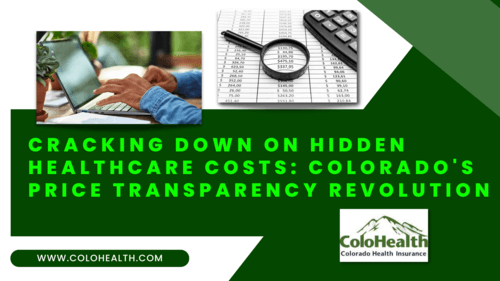
Colorado’s Price Transparency Revolution
But two and a half years ago, Congress passed laws directing hospitals and payers to put a stop to it.
One of the laws, the Transparency in Health Care Act, expressly requires hospitals to put clear pricing information on their websites, freely available, and presented in such a way that the average consumer can understand.
Since January 1st, 2021, The Center for Medicare and Medicaid Services final hospital price transparency rule CMS’s price transparency rule requires hospitals to post a machine-readable list of their services and prices.
They must also post on their websites a patient-friendly tool to help them shop for 300 common services.
The goal is to force providers to compete on an even playing field, and to allow consumers to more easily shop for the best available pricing for these common procedures.
Combined with other ratings data, outcomes measures, and patient reviews, patients would also be able to compare the quality of services received as well as the price.
Hospitals Are Not Complying
Hospitals have been dragging their feet. As of mid 2023, only about a third of hospitals nationwide have meaningfully complied with the law at all.
The PatientsRightsAdvocate.org’s fifth Semi-Annual Hospital Price Transparency Compliance Report found that only 36% of the 2,000 hospitals reviewed were fully complying with the federal Hospital Price Transparency Rule. These findings mark a slight improvement in compliance from the report released in February showing just 24.5% compliance.
Colorado Lagging Behind Nation in Transparency Compliance
In Colorado, compliance metrics are even worse: Only about 18% of hospitals have complied with the federal price transparency law.
The vast majority of hospitals in Colorado are well out of compliance. They have failed – or refused – to make their pricing information available to ordinary consumers.
So when it comes to effectively shopping for health care procedures – anything from MRIs to knee replacements to cancer treatments to childbirth – Colorado’s consumers are still effectively left in the dark.
This is unacceptable.
Through Congress and the Colorado State Legislature, voters have made it crystal clear that they want to break up the secretive pricing cartel arrangements between hospitals and insurance companies.
They also want to eliminate unfair and sometimes outrageous pricing discrepancies that distort the free market and enable hospitals and other providers to exploit confused consumers and gouge patients in their most vulnerable moments.
For example, some instances, an X-Ray or MRI imaging session or childbirth could cost up to ten times as much for one patient than another – even at the same hospital.
 FREE QUOTE
FREE QUOTE
COLORADO HEALTH INSURANCE
Colorado Legislature Takes Action
Unfortunately, the U.S. The Department of Justice and the Department of Health and Human Services have shown little inclination to enforce the law on behalf of healthcare consumers.
And so the Colorado State Legislature has stepped in.
A new law, recently signed by Colorado Governor Jared Polis, authorizes Colorado’s Attorney General to levy steep fines against Colorado hospitals that fail to comply.
According to the new law, hospitals that don’t publicly post their pricing information on their Websites could get tagged with deceptive trade practice, and face a fine of up to $20,000 per violation.
The bill’s chief sponsors in the House were Representatives Anthony Hartsook and Lindsey Daughterty, while the primary sponsors in the Senate were Kevin Van Winkle and Julie Gonzalez.
In addition to the fines for non-compliance, the law also short-circuits the efforts of hospitals to collect on medical debts incurred by consumers while the hospital was not in compliance with the law.
Under the new Colorado statute, any customer who is subject to a collection action from a hospital, and who believes the hospital had not posted its pricing information as required by the law at the time they incurred the debt, can sue the hospital.
If a judge or jury finds for the plaintiff, the hospital must refund the patient everything they paid, and pay a penalty equal to the total amount of the debt – plus attorneys’ fees and any other costs the patient incurs as a result of the hospitals’ faulty collection action.
The hospital must also remove any negative information about the collection from the patient’s credit report.
Under the law, hospitals who accept Medicare patients have until October 1st of this year to post their Medicare reimbursement rate information on all procedures done in the hospital.
You can read the full text of the law here.
Transparency is Good For All Coloradans.
If hospitals can be brought into compliance, the pricing information would be very good for Colorado healthcare consumers.
Full price transparency would level the playing field, and allow consumers to shop around at different providers for common medical procedures and prices. When combined with outcomes data, consumers can also compare not just pricing data, but also data on the quality of healthcare.
Full transparency would also benefit employers, insurance companies, and municipalities working to control their employee healthcare costs.
Full transparency would also make it easy for data aggregation websites to publish easy-to-understand healthcare data so people can compare prices and quality information from dozens of providers at a single site – as we are already accustomed to doing at sites like Expedia.com, Priceline, and Kayak.com.
It’s not a Panacea. But it is a vast improvement compared to the climate of secrecy and collusion that existed prior to Healthcare Transparency.
Here are some additional blogs on the topic: Why Are Health Insurance Companies Leaving Colorado? | As the Colorado Public Option Fizzles, Legislators Scramble to Find a “Fix.”
Here are some additional pages related to this article: HSA Secure in Colorado | Direct Primary Care with a DPC DIRECT Healthshare Plan
 FREE QUOTE
FREE QUOTE
COLORADO COST-SHARING
Frequently Asked Questions About Colorado's Price Transparency
 What is healthcare price transparency?
What is healthcare price transparency?
Healthcare price transparency refers to making the prices for healthcare services available to consumers before services are rendered.
The goal is to help patients make more informed decisions about their care, help reduce healthcare costs, and encourage competition among healthcare providers.
 Why is healthcare price transparency important?
Why is healthcare price transparency important?
Price transparency is essential because it can lead to more effective competition and price reductions in the healthcare market.
It allows consumers to compare prices for services, which can promote more informed decision-making and potentially result in lower healthcare costs.
 What are the challenges to achieving price transparency in healthcare?
What are the challenges to achieving price transparency in healthcare?
Challenges include reluctance among providers and insurers to disclose negotiated prices, complexity of healthcare pricing, variability in individual health care needs, and difficulty translating medical procedures into easily understood services or products for comparison.
 How does healthcare price transparency affect medical practices?
How does healthcare price transparency affect medical practices?
Price transparency may lead medical practices to standardize and rationalize pricing.
Practices may face increased competition, and potentially, an emphasis on cost-effective care. They might also see increased administrative tasks related to price disclosure.
 Does healthcare price transparency lead to lower costs?
Does healthcare price transparency lead to lower costs?
Theoretically, it can, by promoting competition and encouraging consumers to choose lower-cost providers.
However, it also depends on other factors like market dynamics, consumers’ ability to understand and use price information, and the nature of healthcare demand.
 Can price transparency negatively affect patient care?
Can price transparency negatively affect patient care?
If not properly implemented, it could lead to an overemphasis on cost rather than quality of care.
There could also be an unintended consequence where providers increase prices to match higher-cost competitors, assuming higher price signals better care.
 How can price transparency be improved in the U.S. healthcare system?
How can price transparency be improved in the U.S. healthcare system?
Price transparency could be improved through standardized disclosure practices, integrating price information with quality data, consumer education, and stronger enforcement of price transparency rules.
 What is the future of healthcare price transparency?
What is the future of healthcare price transparency?
The future is likely to involve greater transparency due to consumer demand and legislation.
The aim is to shift towards a more consumer-centric model where patients can easily access, understand, and use price information to make informed healthcare decisions. However, the transition is complex and requires cooperation from all players in the healthcare system.
 What is the Hospital Price Transparency Rule?
What is the Hospital Price Transparency Rule?
The Hospital Price Transparency Rule, effective as of January 2021, mandates that hospitals in the U.S. must publish their standard charges online in a machine-readable format.
This includes the rates they negotiate with insurers, the amount they are willing to accept in cash from a patient, and the minimum and maximum negotiated charges.
 What is the current state of healthcare price transparency in the United States?
What is the current state of healthcare price transparency in the United States?
The federal Hospital Price Transparency Rule requires hospitals to provide easily accessible billing information to patients.
This includes the disclosure of negotiated rates with insurers and the minimum and maximum negotiated charges. However, full price transparency is not yet a reality in many aspects of the US healthcare system.
 What is the impact of the Hospital Price Transparency Rule?
What is the impact of the Hospital Price Transparency Rule?
While it’s too early to assess the full impact, the rule is intended to give consumers the ability to shop and compare prices across hospitals and estimate the cost of care before service.
It is also intended to encourage hospitals to offer more competitive pricing. However, over the first two-and-a-half years of implementation, only a little over a third of hospitals are substantually compliant with health care transparency rules.
 What is the role of insurers in healthcare price transparency?
What is the role of insurers in healthcare price transparency?
Insurers play a crucial role as they often negotiate prices with healthcare providers.
In a fully transparent system, insurers would reveal these negotiated rates, enabling consumers to understand the costs of services before they are rendered.
 What is the relationship between price transparency and healthcare quality?
What is the relationship between price transparency and healthcare quality?
Price transparency alone does not guarantee quality.
The goal is to pair price information with quality metrics to help patients make informed decisions. The relationship is complex, and higher price does not always mean higher quality in healthcare.
In a fully transparent system, insurers would reveal these negotiated rates, enabling consumers to understand the costs of services before they are rendered.
 What are “surprise bills,” and how can price transparency help?
What are “surprise bills,” and how can price transparency help?
Surprise bills are unexpected charges that patients receive when they get care from out-of-network providers, often unknowingly.
With price transparency and clear network information, patients can better avoid such scenarios.
 What role does legislation play in promoting healthcare price transparency?
What role does legislation play in promoting healthcare price transparency?
Legislation is crucial for enforcing transparency.
The Hospital Price Transparency Rule is an example of legislation aimed to promote transparency. Further legislation could mandate more sectors of the healthcare industry to disclose prices.

Wiley Long is the president of ColoHealth, and has been in the health insurance industry since 1987. He received his master’s degree in nutrition and exercise science at Colorado State University, and is passionate about individual healthcare freedom. Read more about Wiley on his Bio page.






